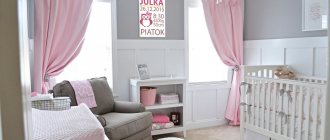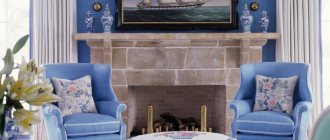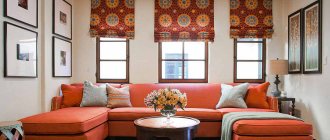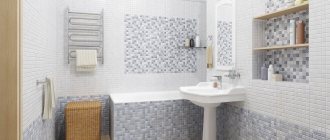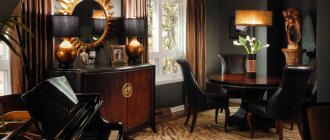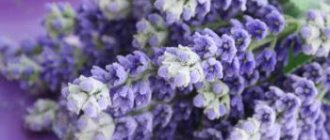Creating a classic shade
Unfortunately, no matter what components are mixed, without the primary tone itself it will not be possible to even come close to creating the required shade.
Red and yellow colors follow the same rule.
If the color in your palette is too dark, then white paint will help to lighten it a few tones.
If, on the contrary, you need to darken the shade, then you need to add more dark tones to the mixture - black, gray or brown.
Important!
If you are mixing colors to create a small pattern in the interior, then you can mix them in a small bowl by hand. If you want to paint an entire wall, tint the ingredients in a bucket using a mixer.
Mint in the bedroom
Textile curtains and bed linen in the interior of a classic mint bedroom
The combination with white can be successfully used in the bedroom; moreover, such a solution can visually expand the space and make the room brighter.
Mint color combination in the interior
Mint color in the bedroom interior creates an atmosphere of peace, comfort and tranquility. A mint bedroom will please the eye, give you a good mood and pleasant dreams.
Mint color in the bedroom interior
Mint accents in the form of pillows and bedspreads in the bedroom interior create a cozy atmosphere
How to maintain proportions
How to get blue color by mixing:
- Get delicate ultramarine by mixing blue and white parts in a 3:1 ratio.
- To create a shade with a slight blue, increase the portion of white color. The ratio of blue to white is 2:1.
- To obtain a more transparent, light tone, mix them in equal proportions.
Advice !
The heavenly color is perfect for painting a boy’s nursery.
A turquoise tone will help you get a more saturated heavenly tone.
A complex recipe of three ingredients will help you create an aqua color.
How to make blue using turquoise and white? Take 2 parts blue paint, 1 part white and turquoise. Enjoy the blue of the sea.
This is interesting!
Red, blue, yellow are called primary, because by mixing other tones it is not possible to achieve the desired shade. Why do you need to know what colors need to be mixed to make blue? To achieve a play of shades and original texture, create artistic masterpieces.
Dark shade
In the case when you want to make the color darker, the mixing recipe is a little more complicated. It all depends on what the final result is and how rich the tone you are trying to achieve.
How to successfully mix different tones to get a dark blue color:
- You will need two paints: black and aquamarine. If the tone is made to decorate parts, then stir the mixture with a brush or stick in a small container. To paint walls, you need to tint the shade with a construction mixer, a special attachment for an angle grinder.
- There are no exact proportions.
Add black color to the base paint drop by drop or a few milliliters. - It is better to test the resulting mixture on a sheet of white paper and let it dry. If you are satisfied with the shade, then stop tinting. If not, add even more black.
Advice!
Did it get dark? Lighten the mass by several tones using white. Stir in gradually so you don't have to add black again.
Violet
Ultramarine is similar to artificial, which does not occur in nature. Purple will help create paint the color of a dark sky.
Magic coloring will help create an interesting tone that can be used to paint the ceiling in the nursery, and bright luminous star stickers will create an imitation of the night sky. How to get blue from purple:
- Mix blue paint with purple in proportions 3:1.
- For the ceiling, knead the dye with a construction hook for about 10 minutes.
- Test the finished mixture on a small section of the wall. Do not forget that you need to apply the interior color in 2-3 layers.
A woman's favorite shade is royal ultramarine.
To get such a noble tone on the verge of night blue and sea wave, you need an acidic violet color or pink. The recipe is similar to the previous tinting:
- You will need 2 tones: acid violet (pink) and ultramarine.
- The proportions of blue and pink are 3:1. Sometimes you need a little more pink.
- Evaluate the result by applying the dye to a small area.
Advice!
To get purple, mix red and blue in equal proportions.
Understanding mint
Mint is a shade of light green diluted with blue paint. It can be obtained by mixing blue with various green shades or diluting dark green with white. You can clearly see it in the palette below. To create a soft and warm color, use more blue, and add aquamarine to create a cool tone.
What do you associate mint with? Surely with summer or spring, sunshine and youth. That is why walls painted with mint paint create the illusion of coolness in the summer, and in the fall they will charge you with positivity and freshness. By the way, it is this shade that calms the psyche; it’s not for nothing that the walls of kindergartens and hospitals are painted mint. Designers believe that this color can calm, create a feeling of security and comfort, so they recommend using it in children's rooms, bedrooms and living rooms. Objects in this color seem old and have lost their brightness. The shade is ideal for creating a retro look in your apartment.
And so, many people try to use mint color in the interior, because it does not irritate or bother the owners at all. In your apartment, you can use mint color as the main one, or you can place several objects or details in the room.
From yellow
To create an emerald blue color based on ultramarine, you need yellow.
The resulting shade is similar to the shine of precious stones. It is appropriate to use it for decorating small elements to create a fantastic picture. How to get blue from yellow:
- Mix yellow and ultramarine colors in equal parts.
- For a pastel look, add white. The proportion recipe depends on the desired degree of pallor.
Advice!
To create a fantastic shimmery color, do not stir the paint too thoroughly. A lazy tinting method will create an interesting mother-of-pearl effect.
Useful video: how to mix colors
Combine combinations of warm shades with delicate pastels, blue tones with cold ones. Change the proportions to your liking; proper tinting is the key to successful repairs. Experiment and create your own color scheme!
Brown paint is found quite often in everyday life. In addition to interior design, it may be needed when painting with gouache, acrylic or watercolor paints. Having become familiar with the secrets of mixing techniques, you can easily obtain not only pure brown paint, but also all kinds of shades of brown.
Accessories
Stylish accessories will add liveliness and taste to any room, especially if they are bright mint shades. Such elements will attract everyone's attention, and the monochromatic interior will sparkle with new colors!
Such beautiful, refreshing bed linen will decorate your bedroom.
Light blue stool in retro style
The use of soft blue shades in the interior will make the black and white design of the room unique and entertaining.
Light blue tones of cabinetry and accessories
Color combination with mint color in the interior: wood and mint
Ways to get classic color
The answer to the question of how to make a classic brown shade depends on the paints available. There are several mixing options:
- By combining red and green dye. Moreover, the use of dark red and dark green shades is unacceptable, otherwise a background close to black will be formed.
- If the existing paints do not contain a green element, mix blue with yellow and add red.
- Brown paint can be obtained by adding a gray or blue tint to the orange color.
- Those who want to experiment can be advised to mix yellow and purple colors. A violet tone is sometimes used as a substitute for purple.
Attention! The latter method requires particularly careful dosage. The slightest excess of the volume of mixed paints will result in an unnecessary shade.
How to achieve different shades
Classic brown paint is not always needed; often you need to make a lighter or darker tone. We will tell you in detail what colors are needed to get red-brown paint or other halftones.
The easiest way to make dark brown paint is to add black to the existing ingredients. It should be applied in small portions (depending on the total volume) so as not to spoil the desired result. The decision about the need to add a new portion of black is made only after thorough mixing.
The color of dark chocolate, as the dark brown shade is otherwise known, can be achieved in another way. Required:
- orange;
- yellow;
- red;
- Finally, add a little black.
To make brown paint in dark shades acquire an even richer and more intense tone, create a cocktail of blue and yellow with the addition of scarlet. The result should be first-class.
Adding white dyes to the base composition will help you make light brown paint. Lightening colors are used with less caution than darkening ones. In case of overdose, introducing basic tones will help restore saturation. In addition to white, the function of brightening elements is performed by:
- yellow - gives an ocher tint;
- red allows you to achieve a rust effect, it will be interesting for those who want to get red-brown paint.
- The blue ingredient will help make the tone more contrasting.
Comment! To obtain a good quality color, mixing the main components is often not enough. Therefore, it is necessary to turn to a complementary color palette.
Light brown mineral paint is formed by adding ocher, umber or sienna. The richness of earth pigments contributes to excellent results. And finally, a few more combination options for various everyday situations:
- A combination of dark brown and red colors will help you make chestnut.
- White color can lighten chocolate, where blue and orange tones were the source. The result will be a milk chocolate shade.
- In order for brown paint to acquire a golden hue, it is saturated with white and yellow colors.
- If it is necessary to obtain the darkest possible tone from the base color, instead of green in combination with orange, use black color.
Brown mineral paint is used in construction and interior design; the following photo will help you evaluate its appearance:
Using mint color in the design of various rooms
As mentioned above, mint color can be used to decorate a wide variety of rooms. Currently, this color is actively used in the production of finishing materials, furniture, textile solutions and decorative elements. All you have to do is decide whether the mint color will be chosen as the background of the room (unobtrusive pastel shades are suitable), will become the tone of the accent surface (you can use a rich color or a bright print), will it be represented by furniture (for example, upholstery of upholstered furniture or the design of storage systems) or decorative elements (window drapery, decorative pillows on a sofa or bed).
Living room
In the living room, mint color is most often used for wall decoration. This can be either a light, pastel shade chosen to decorate all the walls, or a rich and even bright mint tone, which has become the color scheme for one accent surface. Depending on the intensity of the chosen shade, you can select furniture for the living room seating area. Light furniture coupled with light mint shades will create a delicate and light look, ideal for a small living room. Dark furniture will look contrasting against the background of mint walls, creating a dynamic and non-trivial image of the room.
But not everyone decides to use mint color as the main color of the decoration, even light shades. But using this fresh green-blue shade in the textile decor of the living room will not be difficult. This can be drapery for windows (curtains and drapes, plain or printed), the design of sofa cushions and even the upholstery of basic upholstered furniture - a sofa and armchairs.
Bedroom
In the bedroom, a light mint shade is most often used to create the background of the entire room, i.e. for wall decoration. This design method is suitable even for small rooms - a light and bright image fits perfectly into the atmosphere of rest and relaxation. If the room is located on the south side of the building, then you can use white as a companion to light mint shades - a cool palette will visually “knock down” the color temperature. If the bedroom is located on the northern part of the building, then it is better to use warm wood tones (in furniture, flooring) to balance the color scheme and bring greater warmth and comfort to the interior of the room.
If the bedroom has very modest dimensions and shortcomings in the architectural design and it is impossible to use any other color scheme besides white finishing, then a local design can be selected for the mint tone. This could be textiles on the windows, decoration of the bed, lighting fixtures, carpeting or decorative elements.
Children's room
Mint color can have a beneficial effect on the child's psyche; it does not irritate the eyes, and has calming and relaxing qualities. Therefore, it can be used equally effectively both in a room for an active child who needs help calming down and preparing for sleep, and in a nursery for a calm baby, even a newborn - it all depends on the intensity of the shade. To decorate the room, it is better to use a light mint or grayish-mint color, which creates an almost neutral background to effectively highlight the beauty of furniture, textile design, and decor.
Kitchen and dining room
In the kitchen, mint color can most often be found in the design of furniture facades. Considering that most of the kitchen space is occupied by storage systems, the color of the facades largely shapes the image of the room, its character, and color temperature. Light mint shades are suitable for country style kitchens, shabby chic. Richer mint tones are also commonly used in kitchen spaces designed in a modern style.
If you are not ready for the entire kitchen set to be done in mint color, stop at only one tier of cabinets (top or bottom) or use a fresh green-blue tone for the dining area, island or bar counter.
But mint color is also excellent as a background for a furniture set in a kitchen space. A fresh and light image of the kitchen will be provided by a combination of mint finishes and light kitchen facades. If the kitchen cabinets have the color of natural wood, then the entire interior will look harmonious, filling the atmosphere of the room with warmth and comfort.
Bathroom
In the bathroom, mint color looks more than appropriate - fresh, cool, reminiscent of the color of the ocean on a sunny day. To create an atmosphere in which you can not only carry out the necessary water procedures, but also truly relax, take a break from the bustle of the city, mint color can be used both as the main color for wall decoration and for decorating accent surfaces.
Auxiliary premises
Mint color in the hallway or corridor, space near the stairs or on the veranda? Why not. Considering that the auxiliary rooms in most homes do not have windows, light mint shades as a background decoration are not only an acceptable option, but a solution that will help create a fresh, unobtrusive image of utilitarian spaces. A snow-white ceiling, light mint walls and dark flooring will help create an interior in which, in addition to a light and eye-friendly image, you can create a visual increase in space, which is a pressing issue for small rooms.
Advantages of mixing and problematic issues
Deciding to make your own brown by mixing is not always considered the best option. In what cases will brown paint made at home help you achieve your goals and when is it better to avoid experiments by purchasing a ready-made color? Let’s consider in detail:
- The creative process of painting on canvas with acrylic compounds is an ideal field for experimenting with mixing in different proportions and obtaining all kinds of shades.
- When during the renovation process there are suitable jars with unused color, and brown is exactly what is required in the design, please be inspired to search for the right tone.
- If any household need to paint a surface brown is accompanied by a lack of the necessary paint in the store.
- The renovation is in the planning stage, does the interior design include brown? You should not initially purchase various components for mixing; choosing a ready-made color scheme from a wide range of hardware stores will be the optimal solution.
Advice! It is not recommended to experiment with mixing colors when dyeing your hair at home. Leave this field of activity to the professionals or choose a suitable shade from the very beginning.
Little secrets of mixing
Beginning experimenters may find expert recommendations useful:
- If the resulting color does not meet expectations, additional color is added in small portions. This applies to a greater extent to darkening tones; it is possible to correct an excess of the brightening element by increasing the main components.
- The resulting dye is tested on a small area. The surface background will not always correspond to the composition in the jar.
- Before you start adjusting a color you don’t like, wait until it dries on the surface; shades may change over time.
There are many ways to make the desired color yourself. It may be required in the creative process of an artist or designer. But when mixing, the feasibility of experimenting with combinations must be taken into account. It may be easier to turn to the finished product and not resort to experiments.
- If you mix green and yellow colors in equal proportions, you get a color that we usually call light green. Depending on how light or dark the original colors are, the result will vary from light green to olive.
But if you mix green and yellow in clothes, nothing good will come out) This combination can only be worn by representatives of the winter color type, and even then it’s not worth it)
If you take yellow as a base and add green paint, you get a light green color
or shade, since everything will depend on the amount of paint you want to add to the base color.
If you want to continue the experiment, you can add a little white paint to the light green one and get a lighter and less saturated color.
Yellow will give green the opportunity to sparkle with a variety of shades. There will be less yellow - the green will only become slightly brighter, more golden, but if there is more, then the green color can be brought to light green. In general, decide what color you want to get as a result - more yellow or more green, and depending on this, select the desired proportion of mixed colors.
Light green color can be used to paint fresh grass and leaves. It will give the picture a juicy spring character.
Mixing green and yellow dyes will also be useful for cooks: it is this light green color that is most often found on flower petals on cakes.
If you mix any two paints, you can get many different shades. Moreover, depending on how much of one paint is mixed with another, the resulting color approaches either one or another color.
If we have two colors: yellow and green, then mix the colors in equal proportions
will give
a light green
color.
If you gradually add green paint to yellow paint, you can see how the resulting paint changes its color, getting closer to green with each new drop.
Knowing how to get a particular color correctly, you can create completely unexpected shades. And if you add another color
, then you can get, for example, the following colors:
The answers to this question will be different if you do not ask the exact characteristics. The final color when mixing yellow and green depends on their initial shades and saturation. This can be clearly seen from the figure below.
If we mix light green and light yellow, we get a soft light green color.
If we mix rich green and yellow, we get a rich light green color.
If we mix dark green and dark yellow, we get olive color. It can also be intensified to dark olive.
By the way, in life the combination of yellow and green is quite acceptable, for example, in clothes these colors go well together and refresh a woman, and are also acceptable for a man, although they are used less often. The same can be said about their use in the interior of, say, a bedroom.
It will turn out to be an acidic, poisonous light green color - well, that’s just in my personal opinion!)
If you mix yellow and green, you get blue. Depending on the proportions of the colors mixed, the shade of blue will change. If you add more green, you get a dark blue color. And if there is more yellow color, it will turn out blue.
Mixing green with any other colors always results in a color close to brown or even an indeterminate color.
But adding green to yellow dates olive color. If you add just a little yellow, the green color will become more saturated and dark.
By mixing yellow and green colors, we get a bright light green color.
But in order to actually get a bright light green color, the proportions when mixing paints must be the same 1:1.
By adding a little more of one color and a little less of another color, you can get different colors from brown to deep blue and from blue to light blue.
When mixing green and yellow colors, a light green color of varying shades will come out depending on the proportions of these colors. Up to olive color. In general, to put it simply, it will just be a light green color.
It depends in what proportions you mix yellow and green. If the proportions are the same 1:1, then you will get a light green color. Depending on the increase in any color, the shade will change. For example, more yellow, the color will become light green and vice versa.
Theoretical knowledge about color gives the concept that the main colors are: yellow, red and blue. Combining any two of these colors will produce an additional secondary color. contains everything that, when mixed, produces tertiary colors.
Mint color combinations?
In the interior, the combination of mint colors is often based on two principles: when it acts as the main background color, or when it serves as a complementary color in the form of various interior accessories and attributes.
When choosing combinations, do not forget that mint is cool. And when decorating, for example, northern rooms, it is better to choose some warm tone as the main background. For example, cream, with it the interior of any room will not be cold and at the same time will be harmonious. A room decorated with this combination looks noble, and a light background will make it visually more spacious.
If you want to dilute the coolness and want to add richness, choose bright yellow, coral or rich light green colors. But there should not be too many of them and it will be better if they are small interior items: souvenirs, vases, decorative plates, small paintings on the walls, etc.
A combination with cooler, metallic colors is appropriate: silver, chrome. This combination is especially useful when decorating an interior in the High-Tech, Modern style. The proximity to the decor of the kitchen and bathroom is also relevant.
In addition, another combination of mint color is in place: with milky, purple, light brown, gray, beige, white, orange, terracotta, pink.
It is also worth knowing that natural mint colors go well with unpainted wooden structures and details present in the interior. And no wonder, because both elements are directly related to nature. In addition, the combination of soft coolness and beautiful warm wood leads to a harmonious balance of the entire environment in the room.
How to get brown using primary colors
To find out how to get brown from paints and what base dyes you need, you need to use the color triangle. to obtain brown, green and red or an equivalent combination of blue, yellow and red will be used.
How to get brown color from paints by mixing primary and secondary colors? You need to mix:
- green and red;
- yellow, blue, red (color pigments must be taken in equal proportions);
- orange and blue;
- gray and orange;
- magenta and yellow;
- yellow, orange and purple (primary colors can be divided into additional colors, according to the color wheel);
- green, purple and orange (green is a combination of yellow and blue, purple is a combination of blue and red, and orange is a combination of red and yellow).
How to get dark brown color
To obtain the desired dark tones of brown, a small amount of black paint is added to the red, orange and yellow pigments. Color saturation is obtained by mixing yellow, blue and red in various proportions experimentally:
- is formed by combining red, yellow and black with a drop of green.
- Mixing red, yellow, white and black produces dark brown.
- The red-brown shade is obtained by the predominance of red pigment in brown paint.
Yellow, blue and red are the main colors that answer the question: how to get brown from paints? Therefore, in order to give the brown color the necessary various shades, use the predominance of yellow, blue or red over other colors (red pigment makes the color warm with a hint of rust, blue gives depth and brightness).

